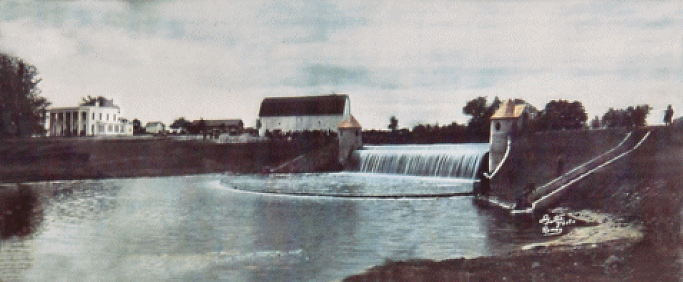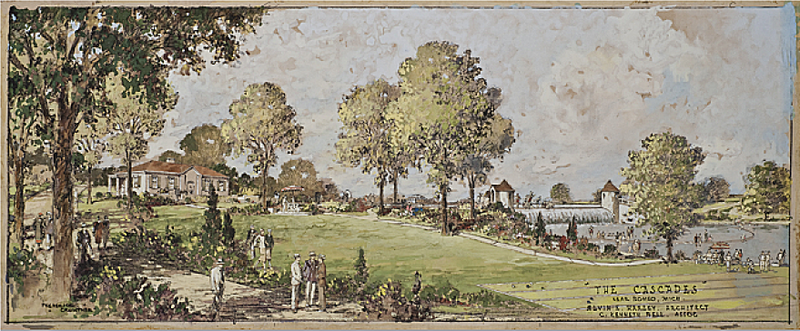
The Cascades
A Distinctive Community for Residence and Recreation

Designed as a place to escape the hustle and bustle of city life, the Cascades was planned to be a distinctive, well-groomed, 230-acre summer home community highlighted by harmonious outdoor surroundings, located 35-miles north of Detroit, where families who lived there could enjoy an array of recreational activities and peaceful country living.
The historic Cascades development was to be located in the northwest corner of Ray Township, Michigan in section six of the historic plat maps, on the west side of Romeo Plank, just south of what is now known as Thirty-Two Mile Road. The area’s land ownership has been traced back to the time when Benjamin Freeman and his wife, Hannah, were awarded land through the United States Federal Land Grant program in 1825. In 1827, the Freeman’s later deeded part of their property to Noah Webster and Ozai and Rhoda Miller. Noah also received 80 additional acres through the land grant program. A sawmill was located on the 80-acre site and it is believed that the site of the mill later became a portion of the Cascades development. After Noah’s death, other portions of the Cascades property were deeded to Norman Perry and Dr. Neil Gray, Jr. who later married Noah’s widow, Maria.
Dr. Gray and his parents emigrated to the U.S. from Scotland in 1831 and acquired property near the Webster and Miller’s parcels. Circa 1848, the Gray family built a stately home on a beautiful rolling hilltop that would eventually become the future Cascades development. The home featured 14 rooms and 5,500 square feet of living space – considered a mansion to many! The $1,000 cost to construct the home made it the first of such expense in Ray Township. Legend (although not proven) says that this home was the first in the area to receive electricity years after it was first built. Although he was a medical doctor by education, Dr. Gray successfully operated a flour and grist mill on this site and along with a few other partners founded the First National Bank, the first bank located in Romeo, MI. He served as president of the bank until his death in 1868. Dr. Gray also owned and operated two other area mills including the Clifton Mills that was once located on what is now known as Thirty-One Mile Road near Mt. Vernon. Dr. Gray actually made his fortune from the mills rather than from practicing medicine. After Dr. Gray’s death, Maria Gray continued to live on the property until she died in 1886 at age 86. Following Maria’s death, sadly, the property was foreclosed and changed ownership a number of times into the 1900’s due to years of legal proceedings.
Back when a number of settlements made up the Township of Ray, Dr. Gray’s property was located in an area that was once known as Selleck’s Corners and also known as Selig’s Corners. Just north of the home, yet still on Dr. Gray’s property, a small one-room schoolhouse was erected and named the Selleck (Selig) School. Later, this school would be renamed the Cascades School, after the property that surrounded the school was sold to a company who had grand visions for the Cascades development.
Around 1918, the G.H and C.G. Currie Company was working in the area, primarily building new roadways in Romeo, when the company owners decided to purchase 230 acres including the Gray family home and outbuildings - circa 1920. Entering the next decade, except for a small recession from 1920-1921, the United States enjoyed a period of sustained prosperity. The Roaring 20’s were in full swing and the Country’s economy was booming. In the late 1920’s, the owners began planning what was to be a magnificent residential development called The Cascades. The planning, plotting and surveying of the property, as well as the design of the development, was contracted to the J. French Paddock and Associates, Civil and Landscape Engineering firm, which was located in the Broadway Exchange Building in Detroit, Michigan. Mr. Paddock, himself, was credited with the excellence of the development’s design as he gave this project his close personal attention. The $200,000 real estate project took over one year of planning and was designed to include a 50-acre lake, building sites for 600 homes, over 5,000 feet of canals, parks, athletic fields, tennis courts, lawn bowling, fishing, rowing, canoeing, horseback riding, hunting and hiking trails, and shopping facilities. A large white barn located on the property that was originally built by Dr. Gray, was to become a bathhouse with showers and lockers. The barn burned down years later. A nine-hole golf course totaling 1,600 yards, dominated the recreational offerings at The Cascades. With its unique traps and water hazards, golfers were challenged to test their approach and pitch accuracy skills, rather than just their ability to drive the ball. Dr. Gray’s home (80 years old at the time) was remodeled into a graceful clubhouse. It was during this time that the front porch and columns were added to the structure.
The dam was the first portion of the development to be constructed. Owens Creek, a north branch of the Clinton River that ran behind the Selleck School, was dammed. This process flooded the flats where the school stood to create the lake. The school was moved farther south and its name was changed to the Cascades School. The 15-foot high and 81-foot long cement dam was not only functional in creating the lake, but it was an attractive structure featuring two beautiful slate roof, turreted stone towers that flanked the north and south sides an 81-foot spillway, and a fish ladder that provided aquatic life with the ability to spawn. Water poured over the dam wall forming a beautiful waterfall. At the base of the waterfall, a half-circle section of water was formed to provide a swimming area. Each of the towers featured winding staircases inside that were accessible via a fern-lined walkway that traveled under the waterfall. Water fell on one side of the walkway, while the lush the greenery grew on the other side. Visitors could climb the stairs to the top of the towers to look out windows for breathtaking views of the countryside. Near the south tower, a hillside patio was built and often served as a bandstand area where people would gather to picnic on the adjoining lawn and enjoy music and the dam.
Perhaps one of the most fondly remembered features of the dam was the multi-colored lights that twinkled at night from under the falling water. Those who remember visiting the site have reported that it was truly a remarkable sight. The clubhouse and dam were opened to the public in 1928, in hopes that it would generate income to help fund construction of the remainder of the Cascades project. Visitors would enjoy community gatherings, excellent cuisine served in the elegant, high-ceiling dining rooms or outdoor patios. Cool evenings were often spent sitting near the huge fireplaces that adorned the clubhouse enjoying the social companionship of other visitors. The dining experience was especially known for complete chicken dinners served for only $1.00.
Lots in the development began to be sold, but sadly, in 1929, the U.S. Stock Market Crash that drove the Great Depression stopped the Company’s vision from becoming a reality. The developers continued to sell parcels up to 1940, and operate the dam and clubhouse, but the remainder of the development never came to fruition. Today, it is believed that only two model homes were constructed as part of the development. With their cottage style architecture, they have been privately owned for years, yet serve as lovely reminders of the charming nature that the Currie’s had envisioned their development to be.
After trying to save the property through legal transfers from one corporation to another, the Currie Company foreclosed on the property and in 1941 is was sold via a tax deed to George R. Morden and his wife. Records show that in 1954, the portion of the property that contained the clubhouse, dam, and a golf course was sold to the Church of Christ Home for the Aged. The church then sold 44 acres of the property to Otis McKinley and his wife, but continued to use the clubhouse as their home for the elderly. The church operated the home until around 1978, when they realized they could not expand the facility further. The home was then leased and used as a home for the disabled. These uses necessitated a number of modifications to the structure in order to meet building and safety codes. Ceilings were lowered, a door and a fire escape were added in a most unusual place, and windows and fireplaces were enclosed and interior walls were moved.
In late 1992, a recently retired local couple and active historians of the area, Bill and Dorothy Collins, were looking for a historic home to restore when they learned that the Cascades property, including the home for the disabled, was for sale. After six months of intense negotiations, they were able to purchase the property along with 29 surrounding acres. They moved into the home in 1993. Bill and Dorothy were no strangers to restorations of old homes. They had successfully restored the 1870 Ransom B. Moore home in Romeo, Michigan to its original Italianate architecture and had served in various positions in the Romeo Historical Society. Shortly after moving in, they eagerly began working on their new project, but, sadly, within a year of starting their renovations on the Gray home, Dorothy passed away. Bill continued to live in and restore the home for the next ten years, but he so missed his wife that he no longer really had his heart in the project. He sold the property to its current owner in 2005. The new owner has a strong appreciation for the historic significance of the home, the dam, and surrounding area and continues to work towards their restoration.
It’s been estimated that water stopped flowing over the top of the dam between 1940 and the mid 1960’s. Photos dated early to mid-1940 and labeled “after the dam broke” show the dam’s structure with no water flowing over, however locals say that it might have been as late as the early 1960’s when the dam stopped functioning as it was intended. Legend states two versions of how this occurred: The first version states that the Department of Natural Resources or a property owner created a break or blasted a hole on the north side of the dam to prevent a natural break. The second version is that the dam walls were washed out in a storm. Whatever the reason, the lake level fell significantly and the area became a marsh. Between 1997 and 2005, supports around the fish ladder and the north tower that flanked the dam collapsed.
By 2010, all that remained of the dam was the south tower, the 81-foot spillway, and the fish ladder balanced precariously on the northern wall. In the summer of 2010, the DNRE – Fisheries Division and the Clinton River Watershed were awarded a grant to remove portions of the Cascade Dam to restore the flow of the North Branch of the Clinton River. The remnants of the north tower, the fish ladder, and 30 feet of the spillway were removed. The northern support walls were angled and the shoreline was stabilized. An area of water was left in front of the dam, but it is believed this will naturally filled in over time. Although still in need of repair, the present owner is preserving the south tower and 50 feet of spillway showing the arched pathway below the spillway. (photo)
The original golf course became part of what is known today as the “Golden Nine” as part of the Pine Valley Golf Course. The restored original Gray home still stands proudly on top of the rolling hill. It is being well cared for by the current owner.
The unique nature of this site has fascinated many people. Through the years, photographers from around the world have stopped to capture images. Many of these photographs have been published in local as well as national publications. With well over 185 years of history, this location provides a rich historical glimpse into the hopes, dreams, and struggles of key Ray Township residents and landowners. Although some of those dreams were dashed, some relics of the things they worked so hard to bring to fruition remain. Gratefully, the caregivers over many years so generously provided the care to ensure this piece of history will remain with us for many more years to come.
A Historical Compilation by:
Constance M. Firestine
May 2010
Edited by the RTHS
January 2011
Sources
Author Unknown (1928, July). The Cascades is a Dream Come True, in Pageant of Progress. Mount Clemens, MI: Nellis Newspapers, (1928), sec. 7.
Bradley, Helen M. (1977, October 12). A Nostalgic Look at the Cascades. Romeo, MI: The Romeo Observer (1977), sec B.
Buzzelli, Elizabeth Kane (1976). A History of the Romeo Community School District 1824-1976. Ann Arbor, MI. Edward Brothers Publishing Inc. pgs. 57-58.
Collins, Bill (2010, April 19). The History of the Cascades. Presented at April 19, 2010 Ray Township Historical Society Meeting, Ray Township, MI
Raiter, Evelyn, (n.d.) Romeo Landmarks, the Cascades. Presented with Ms. Raiter’s artwork entitled “The Cascades”
Selwa, Robert (1994, November 27). Memories Cascade for former Romeo area woman. Mount Clemens, MI: The Macomb Daily (1928), pg. 6B.

